So in our class we discussed the theory/concept of gay window advertising. What it basically means is putting a gay/queer subtext into a piece of media, usually intended for heterosexual audiences, so that it is has a broader appeal. To most consumers, it goes unnoticed and they feel safe being out of the gay target as it is not always too overtly gay; they can just assume it is being presented as the norm. Queer subtext is typically found in advertising. Since men's clothing is indeed for men, comprising of heterosexuals, homosexuals, somewhat in between or undefined, companies need to appeal their product to as many of the consumers as possible in a singular ad. This is a) to save money (it's probably too expensive to shoot a gay version of an ad right after the hetero, and b) to show that there is no preference over either consumer. They want to create the hegemonic idea of their company being open to all clientele.
To explore this, and see if gay window advertising exists, I went to Indigo and purchased the latest issue of GQ (a men's fashion/lifestyle magazine typically read by hetero men) and the latest issue of OUT (a men's fashion/lifestyle magazine typically read by gay men) and took a look at their ads.
First I think I'll look at the ones from GQ:
 This one goes very much along the line of the so-called 'beefcake' pose. The man is rugged and masculine, but also toned, buff, and exposed. It presents an idea of dominant hetero-masculinity, but is a gay viewing pleasure as the man can be gazed upon. For hetero-audiences, the man is the subject of focus, as he is wearing the clothing being modeled. However, for gay-audiences, in addition to being the subject of focus, the model is also the object of focus. His hyper-sexuality becomes a gay viewing pleasure. Therefore this ad can fall under the subjection of gay window advertising.
This one goes very much along the line of the so-called 'beefcake' pose. The man is rugged and masculine, but also toned, buff, and exposed. It presents an idea of dominant hetero-masculinity, but is a gay viewing pleasure as the man can be gazed upon. For hetero-audiences, the man is the subject of focus, as he is wearing the clothing being modeled. However, for gay-audiences, in addition to being the subject of focus, the model is also the object of focus. His hyper-sexuality becomes a gay viewing pleasure. Therefore this ad can fall under the subjection of gay window advertising. While this ad is not overtly masculine, it has a very strong (perhaps the stongest) gay subtext. Although the man is not dressed in any stereotypical homosexual way (and therefore can been deemed straight?), his actions allude to homosexuality. The slogan is "Time to Shop!", with pink/red stars around it. Shopping is typically viewed as a gay activity, rather than a straight man's activity. Why would this be in a GQ and not OUT? Perhaps since GQ is not a magazine read exclusively by heterosexuals, Macy's thought it to be important to appeal to the gay readers, but not so openly. Although the man is excited and jovial, he is still presented to be masculine (businessman, mid-age: if trying to appeal to exclusively gay men, perhaps they would use a much younger man?).
While this ad is not overtly masculine, it has a very strong (perhaps the stongest) gay subtext. Although the man is not dressed in any stereotypical homosexual way (and therefore can been deemed straight?), his actions allude to homosexuality. The slogan is "Time to Shop!", with pink/red stars around it. Shopping is typically viewed as a gay activity, rather than a straight man's activity. Why would this be in a GQ and not OUT? Perhaps since GQ is not a magazine read exclusively by heterosexuals, Macy's thought it to be important to appeal to the gay readers, but not so openly. Although the man is excited and jovial, he is still presented to be masculine (businessman, mid-age: if trying to appeal to exclusively gay men, perhaps they would use a much younger man?).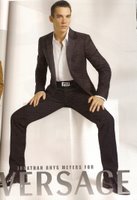 I find the Jonathan Rhys Meyers ad to be very open to a queer reading. Look at his pose. There is an emphasis of his sexuality with his legs being spread open in a rather inviting pose. Although fully clothed, it is a provocative display of male sexuality. Although Rhys Meyers himself is a heterosexual, and is dressed rather masculinely, there is such a blatant display of sexual desire for the male viewer.
I find the Jonathan Rhys Meyers ad to be very open to a queer reading. Look at his pose. There is an emphasis of his sexuality with his legs being spread open in a rather inviting pose. Although fully clothed, it is a provocative display of male sexuality. Although Rhys Meyers himself is a heterosexual, and is dressed rather masculinely, there is such a blatant display of sexual desire for the male viewer.
 This ad is very open to a queer reading. Although there is not a display of sexuality, oor effemininity, there is still a strong gay vibe. Note the slogan: 'Time Out". Out as in homosexual? It is appears to be a male dominated situation, with 5 men to 1 woman, and the woman is barely visible. The men all appear to be very comfortable together in such a close situation enjoying each others intimate company.
This ad is very open to a queer reading. Although there is not a display of sexuality, oor effemininity, there is still a strong gay vibe. Note the slogan: 'Time Out". Out as in homosexual? It is appears to be a male dominated situation, with 5 men to 1 woman, and the woman is barely visible. The men all appear to be very comfortable together in such a close situation enjoying each others intimate company.Ad's in Both OUT & GQ:
These were some of the ads in both magazines, although there are many of the same advertisements in both, I chose these two to critique. Clearly as they are in both, there is an endorsement towards the straight and gay male consumer.

Three men out having a good time. That is what this ad depicts. Not so gay right? However, note the slogans: 'Be Fabulous' and 'Beauty Sleep is Only For Those Who Need It". This advertisement has a gay subtext primarily through it's wordings. 'Fabulous' is not a word that is (if ever) used to describe heterosexual men, it is rather a word used by homosexual men. There is a stereotype of them refering to themselves and their friends as being 'fabulous' or 'fab'. The gay viewer will more likely pick up on this rather than the hetero viewer as they are not exposed to this wording as much. In terms of the other slogan, there is more of an awareness on the homosexual emphasis on beauty. These men do not need their beauty sleep as they are clearly beautiful. A heterosexual male is more likely to refer to himself as good-looking, not beautiful.
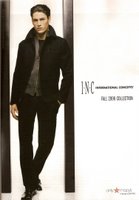
Now, while this ad seems pretty normal to most consumers, it has a strong subliminal gay hint. Some could see this man as merely resting or posing. Others could see him as cruising, which is a term for a man out looking for gay sex. Although he is in a fairly relaxed pose, his eyes and body language conveys desire. Desire for rest, or desire for sex? It is up to the viewer/consumer to decide.

Three men out having a good time. That is what this ad depicts. Not so gay right? However, note the slogans: 'Be Fabulous' and 'Beauty Sleep is Only For Those Who Need It". This advertisement has a gay subtext primarily through it's wordings. 'Fabulous' is not a word that is (if ever) used to describe heterosexual men, it is rather a word used by homosexual men. There is a stereotype of them refering to themselves and their friends as being 'fabulous' or 'fab'. The gay viewer will more likely pick up on this rather than the hetero viewer as they are not exposed to this wording as much. In terms of the other slogan, there is more of an awareness on the homosexual emphasis on beauty. These men do not need their beauty sleep as they are clearly beautiful. A heterosexual male is more likely to refer to himself as good-looking, not beautiful.

Now, while this ad seems pretty normal to most consumers, it has a strong subliminal gay hint. Some could see this man as merely resting or posing. Others could see him as cruising, which is a term for a man out looking for gay sex. Although he is in a fairly relaxed pose, his eyes and body language conveys desire. Desire for rest, or desire for sex? It is up to the viewer/consumer to decide.
Lastly, one thing I wanted to look at was something that struck me in comparing the magazines. These are the ads for Levi's jeans. The First comes from OUT, the second from GQ.
 <--From OUT. From GQ -->
<--From OUT. From GQ -->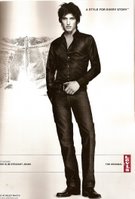
These ads are both for the same product. The OUT ad however, is way more openly sexual than the other. Why is this? Why did Levi's choose to have to very different advertisements? I found the GQ ad rather hard to queer since the model has no dominant presence, and seems pretty asexual, which could be the intention. It is just so much tamer than the OUT one. Perhaps Levi's felt that GQ readers would not respond well to such a hot man wearing the jeans? It has such a high gay viewing pleasure, as there is clearly such objectivity of the model here, maybe the just thought it would be too much to put it in GQ and keep it OUT.
Thoughts?
Thanks for reading my first entry! More to come!
PS: I just thought I'd add this. It came from OUT. Can you EVER imagine seeing this in a straight magazine?!


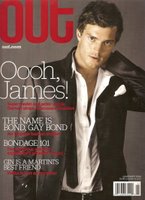
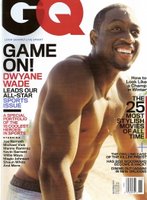

No comments:
Post a Comment